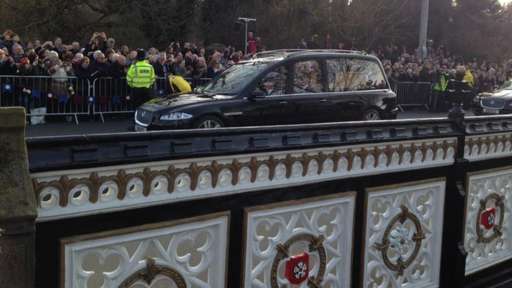 |
| Richard III passes by me as I take a photo on the front row (last on the right, bottom right corner) |
An early spring sun set over the City of Leicester and the thousands of people who lined the streets to watch the reinterment procession of the last Plantagenet king.
The sun glinted down High Street and on to the polished battle armour of the two medieval knights on horseback who led the procession. They guarded a horse-drawn carriage that carried an understated Engish oak coffin crafted by Canadian cabinet maker, Michael Ibsen. Inside the coffin were the remains of Ibsen's 17th great grand-uncle and 15th Century monarch, Richard III.
Richard III's journey through Leicester and it's surrounding villages began six hours earlier at the University of Leicester. A ceremony led by University of Leicester Chancellor Lord Grocott saw attendees symbolically place individual white roses on to the coffin of the the last king to die in battle during the Wars of the Roses.
 |
| Michael Ibsen places a white rose on Richard III's coffin (Leicester Mercury) |
The king left Leicester on 21 August 1485 to meet Henry Tudor at the Battle of Bosworth and a hearse carrying the coffin travelled to the battleground at Fenn Lane Farm for a private service. Phillipa Langley, major contributor to the king's 2012 discovery, carried a casket containing the soils from the land where Richard III was born (Fotheringhay), lived (Middleham) and died (Fenn Lane). The soils will later be scattered into the tomb in Leicester Cathedral when the king is reburied on Thursday 26 March.
From Fenn Lane Farm, the cortege went through the villages of Dadlington (resting place of many of the Battle of Bosworth's fallen soldiers), Sutton Cheney (where Richard III took communion before the battle) and Market Bosworth.
Another ceremony at the Bosworth Battlefield Centre saw the coffin being pulled on a gun carriage by local army cadets. Rt Rev Tim Stevens, Bishop of Leicester, led a service where the Bishop recalled that, "Richard was carried from this field to Leicester as a defeated man... Today, 530 years later, we have an opportunity to allow Richard to take that journey again but this time with the dignity which befits a king."
A 21 gun salute fired by re-enactors on replica cannons followed as the cortege made its way back to Leicester via the villages of Newbold Verdon and Desford. In August 1485, Richard III's battle ravaged naked body was strewn over the side of a horse and rode back to Leicester to be paraded by a victorious Henry VII. The journey to Leicester via Bow Bridge was more dignified this time as people along the route threw dozens of white roses on to the hearse in respect.
 |
| Richard III's hearse crosses Bow Bridge (BBC) |
The coffin was transferred to a horse drawn carriage after a short service at St. Nicholas Church and the armoured escort took the cortege down High Street.
The crowd that had gathered around Leicester's Clock Tower let out a cheer as the cortege emerged from the crowded corner of Eastgates. The 19th century Clock Tower includes a statue of Simon de Montford, Earl of Leicester, who rebelled against King Henry III's overbearing rule. De Montfort was killed in battle by Roger Mortimer, Richard III's 7th great grandfather, but it was De Montfort's statue who looked down upon Richard III as a requiem played through the speakers beside the Clock Tower.
 |
| Simon de Montfort's statue on the base of the Clock Tower looks on (photo by Adam Hodges) |
The medieval cortege made it's way past outlets including McDonalds, Vape Joy and Poundland whilst onlookers took photographs with telephoto lenses and smartphones. Richard III's coffin stopped in front of Leicester Cathedral yards from where he was discovered underneath a council car park in 2012. Richard Buckley, Director of University of Leicester Archaeological Services, formally handed over the king's remains to the Dean of Leicester, the Very Revd David Monteith, as the Cathedral bells tolled.
 |
| Richard III's armoured escort passes McDonalds (photo by Adam Hodges) |
The knights remained on horseback and guarded the Cathedral entrance as the coffin was taken inside. A Service of Compline took place in the cathedral where Richard III's coffin was adorned with a specially commissioned funeral pall, medieval bible and a replica of the King's crown was laid on the coffin by nine-year-old Emma Chamberlain from the 1st Aylestone Brownies.
 |
| Richard III inside Leicester Cathedral (Leicester Mercury) |
The sermon given by Cardinal Vincent Nichols, Archbishop of Westminster, during the service described Richard III as a "child of war" and "refugee in Europe" who became King and "reshaped vital aspects of the legal system."
Richard III will remain in repose until Thursday when a Service of Reinternment at Leicester Cathedral led by the Archbishop of Cantebury will see a reburial fit for a king.

Phillipa Langley wasn't just a "major contributor" to finding King Richard. She found him through her diligent research and perseverance. She deserves the credit for this. So stop sidelining her.
ReplyDelete